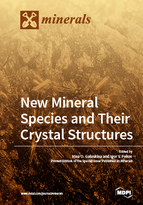New Mineral Species and Their Crystal Structures
A special issue of Minerals (ISSN 2075-163X). This special issue belongs to the section "Crystallography and Physical Chemistry of Minerals & Nanominerals".
Deadline for manuscript submissions: closed (30 September 2018) | Viewed by 63190
Special Issue Editors
Interests: new minerals; crystal chemistry; pyrometamorphic rocks; skarns; rodingites; Raman spectroscopy; crystal growth
Special Issues, Collections and Topics in MDPI journals
Interests: mineralogy; crystal chemistry of minerals and inorganic compounds; rare elements; microporous materials; geochemistry of alkaline rocks and postvolcanic processes
Special Issues, Collections and Topics in MDPI journals
Special Issue Information
Dear Colleagues,
We have the pleasure to invite you to participate in a Special Issue of Minerals, devoted to new minerals and their crystal structures. In comparison with more than a million inorganic synthetic compounds, the number of currently-known mineral species slightly exceeds 5000. Each discovery of a new mineral, studied in detail and accompanied with rigorous descriptions, seem to be an important scientific event. New minerals widen our knowledge on the forms of concentrations of different chemical elements, including the rarest ones, in natural systems. Many of them demonstrate novel, sometimes very unusual structure types and intriguing properties. New mineral species attract attention as sensitive indicators of physical and chemical conditions of rock-forming processes in geology and as potential prototypes of new crystalline materials in modern technologies. And, surely, mineral diversity is one of most wonderful phenomena of nature.
Prof. Dr. Irina O. GaluskinaProf. Dr. Igor V. Pekov
Guest Editors
Manuscript Submission Information
Manuscripts should be submitted online at www.mdpi.com by registering and logging in to this website. Once you are registered, click here to go to the submission form. Manuscripts can be submitted until the deadline. All submissions that pass pre-check are peer-reviewed. Accepted papers will be published continuously in the journal (as soon as accepted) and will be listed together on the special issue website. Research articles, review articles as well as short communications are invited. For planned papers, a title and short abstract (about 100 words) can be sent to the Editorial Office for announcement on this website.
Submitted manuscripts should not have been published previously, nor be under consideration for publication elsewhere (except conference proceedings papers). All manuscripts are thoroughly refereed through a single-blind peer-review process. A guide for authors and other relevant information for submission of manuscripts is available on the Instructions for Authors page. Minerals is an international peer-reviewed open access monthly journal published by MDPI.
Please visit the Instructions for Authors page before submitting a manuscript. The Article Processing Charge (APC) for publication in this open access journal is 2400 CHF (Swiss Francs). Submitted papers should be well formatted and use good English. Authors may use MDPI's English editing service prior to publication or during author revisions.
Keywords
- new mineral
- crystal chemistry of minerals
- crystal structure
- new structure type
- mineral group
- mineral classification
Related Special Issue
- New Minerals in Minerals (20 articles)







